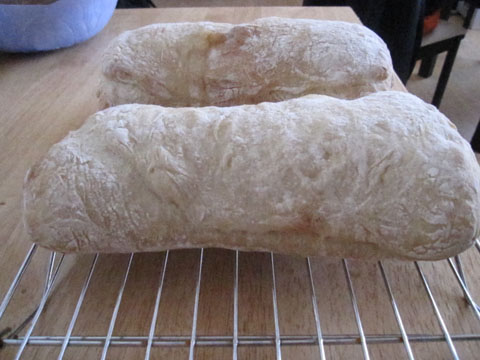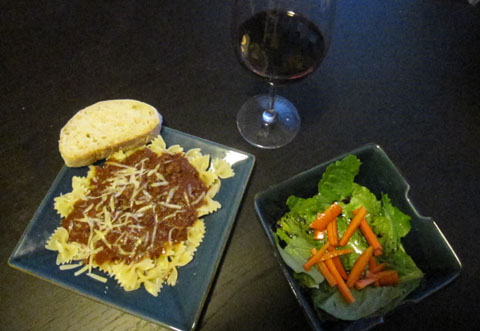Tag: bba
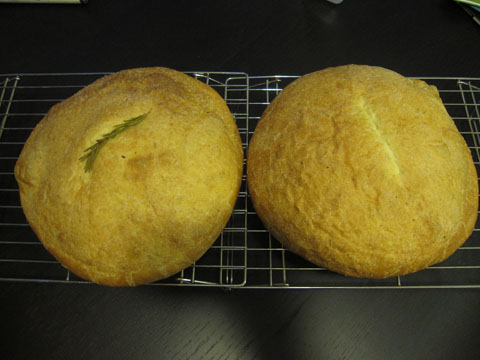
For this bread, we get a new ingredient to play with. Potatoes! I cooked up a batch of Yukon Gold potatoes (From Zuckerman Farms @ the
Hollywood Farmers Market) to make the mashed potatoes for this loaf.

My round loaves didn’t turn out to be as thick in the center as I would have liked, but it tasted good. I spread some fresh avocado on some toasted slices for lunch one day and it was heavenly.
Permanent link to this article: https://www.rhinoblues.com/thoughts/2010/06/potato-rosemary-bread/
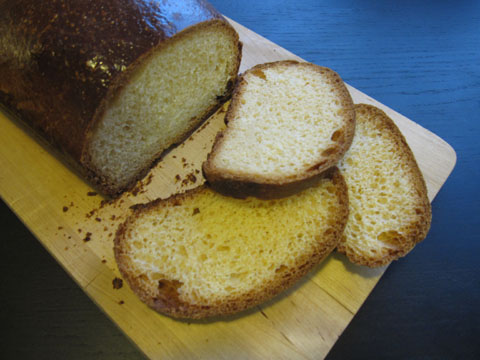
Peter Reinhart describes this bread as the east coast version of the popular Hawaiian style bread on the west coast. They are both sweet breads for sure, but I think this formula at least has a little more fruit forward flavor (the citrus extracts really stay present in the baked loaf). While this loaf uses a sponge, it does not need an overnight rest like many of the other breads I’ve made. The sponge has a relatively large amount of yeast for the size of the sponge.

After the sponge is nice and bubbly, it was time to mix the rest of the dough. First step was to mix up some of the liquid ingredients. Eggs, some vanilla, orange, & lemon extract.

To this mixture I added the sponge and the remaining flour and mixed until the ingredients formed a course ball.


Because this bread has a high fat content, it takes a little more time
to knead than one of the more lean breads (like French Baguettes). I
think I kneaded this for almost 15 minutes. Then it was time to let it rise.

While the formula suggested baking these in round pie pans, I decided i wanted these as sandwich loaves. They took quite awhile to proof, and even then they were a little smaller than I would have liked. The nice deep caramel color of the tops of the loaves were due to an egg wash applied just before baking. Another popular loaf among my co-workers. I’ve already got requests for another batch.
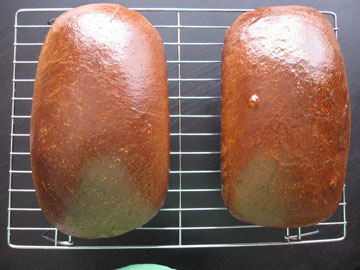
Permanent link to this article: https://www.rhinoblues.com/thoughts/2010/06/portuguese-sweet-bread/
I didn’t get too awful creative with shaping my
Pain de Campagne loaf. A simple round with some cuts in the top to try and make some peaks. They didn’t end up coming out as pretty as the ones in the
BBA. This bread is very similar to your standard french baguette, however its got a small percentage of whole wheat flour added to it.

I’m not quite sure it baked long enough, as it ended up a little denser than I expected. However by the time I sliced it open the next morning, it was still plenty tasty.
Permanent link to this article: https://www.rhinoblues.com/thoughts/2010/05/pain-de-campagne/
This is the style of bread I think of most often when I think about a good artisan bread in America. Pain à l’Ancíenne is a simple rustic dough that in this case benefits from a long slow fermentation. The dough is a wet dough (more like ciabatta than a traditional french baguette). It ferments at refrigerator temperature for anywhere from 12 – 18 hours preferably. It is best as a 2 day project, though I ended up making mine in one day, mixing the dough before work (at 4:30am) and doing the typical second day tasks after work (at 5:00pm). This was also to be the first hearth style bread I’d make since installing the unglazed quarry tiles in my oven. My plan was to use 2/3rds of the dough to make baguettes and the other 1/3 to make pizza dough.
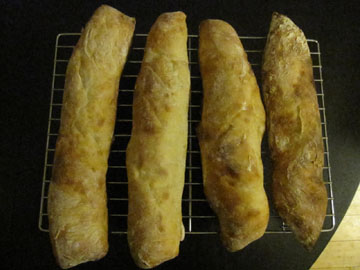
I was pretty please with how the baguettes came out. The one on the right in the picture below ended up a little darker, probably because it was baked by itself. These were small baguettes, ranging from 6 – 8ish inches. One became my lunch the next day…another breakfast the day after. This dough also made a nice pizza dough. I split the remaining dough into two portions and attempted to hand toss them into pizzas. I’ve still got some work to do on getting that technique down. I did manage to shape one into approximately a 12″ round, however it was a little thin in the middle (and probably a little over topped with ingredients). The second portion I just couldn’t get to work and reluctantly through it out. I was just getting too tired to try and save it (plus with a 550 degree oven going for the past few hours, it was pretty hot in the kitchen. The dough made a great pizza dough and the quarry tiles worked better than the pizza stone since I didn’t have to try and aim it correctly on the round pizza stone.
Permanent link to this article: https://www.rhinoblues.com/thoughts/2010/04/pain-a-lancienne/
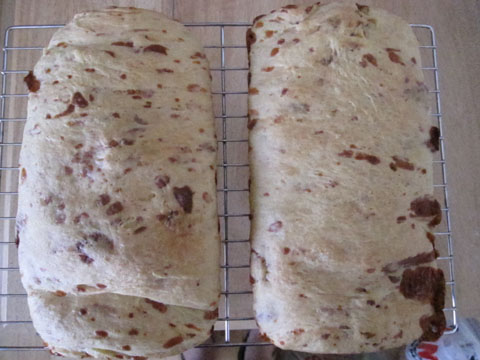
Casatiello is a Brioche inspired bread. The brioche-like dough is flavored with a cured meat (in this case
Soppresetta) and a soft meltable cheese (Provolone with a bit of mozzarella). Definitely a meal in a slice.
A very rich bread (with a bunch of butter mixed in the dough), there was no real danger of finishing off both loaves the same day. This bread could have been shaped in a variety of ways, from roll size (in brioche tins or small lunch bags), to single round, or what I ended up doing…a regular bread pan.
Permanent link to this article: https://www.rhinoblues.com/thoughts/2010/04/casatiello/
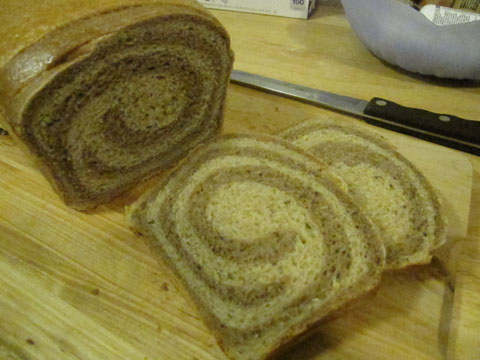
I’ve been making pastrami sandwiches for a lunch lately, so I was pretty excited to make some rye bread to complement them. Plus there was the added fun of a marbled bread!
The tricky thing with a marbled loaf is you need to have both doughs having similar fermentation time. For this reason having everything mise en place is especially important for this loaf. Each of the doughs, are essentially identical, except the darker one has an added coloring agent. I used unsweetened chocolate dissolved in water as my coloring agent.
After proofing, the loaves get an egg wash right before baking to give the nice crust you see below.
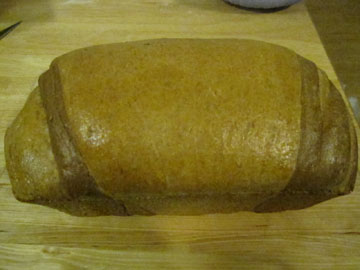
The bread tasted great, it made for a really nice Pastrami sandwich the next day. I also brought it into work and shared with the folks at work. They liked it so much that one of my co-workers offered to pay me to make her some more.
Permanent link to this article: https://www.rhinoblues.com/thoughts/2010/04/marbled-rye/
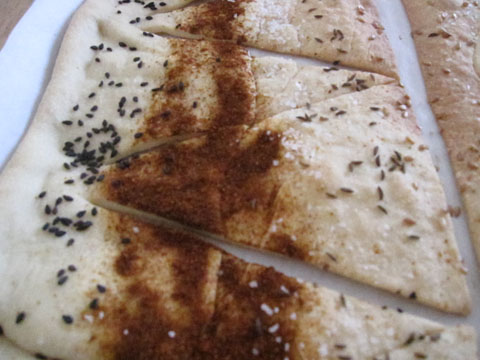
Lavash crackers are the Armenian version of flatbreads that are common among many different cuisines throughout the world (naan, pita, tortillas, etc.). In fact, this dough has much in common with naan and pita. Like those two breads, it is traditionally baked in a
Tandoor oven. Thankfully, these can still be made in a conventional oven quite well.

To bake these, I rolled out the dough as thin as possible and then placed it on parchment on a sheet pan. I used a pizza cutter to pre-cut half of the dough into triangles, leaving the other half to break apart as they would. I flavored the crackers with black sesame seeds, Hungarian paprika, kosher salt, and caraway seeds. (I may have overdone the paprika section though.)
Permanent link to this article: https://www.rhinoblues.com/thoughts/2010/04/lavash-crackers/

This was a fun bread to make. A Sunday afternoon, and I was blessed with the loaves above. It took a couple attempts at the braids, before I figured out exactly what I had to do, but once it sunk in, it was pretty easy. The nice golden color of the loaves comes from an egg wash applied just before baking. Instead of the more traditional sesame or poppy seeds, I topped my loaves with flax seed, which still worked very nicely with the bread.

It’s been awhile since I’ve had commercially produced Challah (at least not as french toast), so I’m not sure how my loaf compares. But we finished off one loaf the first night and the second was gone the next day.
Permanent link to this article: https://www.rhinoblues.com/thoughts/2010/03/challah/
As part of my new found hobby of baking (and the BBA Challenge), I’m trying not to buy store bought bread. Since I had finally used up all the polenta (so couldn’t make the Anadama Bread), I decided to knock off another formula in the BBA Challenge.
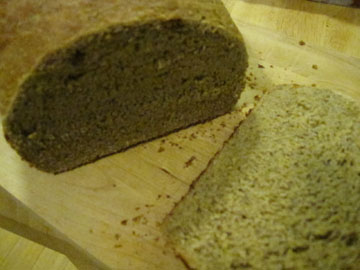
When planning to make the Light Wheat Bread, I decided to get a little adventurous however. I had a bunch of mesquite flour left over from the Mesquite Chocolate Chip cookies (due to a mistake by the mesquite flour company). I figured I’d replace the Whole Wheat flour in the formula with mesquite flour. Other than that, this formula is a pretty typical sandwich bread recipe. Its actually pretty similar to what my grandpa used to make in his bread machine. In addition to the usual suspects of flour, yeast, and water the bread has dry milk and honey (or sugar) to enrich the dough. The mesquite flour gave the bread a very distinct aroma and taste. I used a local sage honey as my sweetener which complemented the mesquite flour quite nicely. The bread definitely had an sweet earthy flavor thanks to the mesquite. It was also denser than I suspect the loaf would have been with whole wheat flour. I don’t think it took anything away from the bread though. It was a fun experiment.
Permanent link to this article: https://www.rhinoblues.com/thoughts/2010/03/light-wheat-bread/

My current KCRW cookbook club selection is
The Southern Italian Table by Arthur Schwartz. While reading through the book after it arrived, I decided I’d take a stab at a sauce that was a fusion of Southern Italian and Spanish/Mexican cuisine. A ragu with chocolate. Since I knew I’d be making pasta, I decided it was time to take on Ciabatta in the BBA Challenge.
For the Ciabatta, I started with a poolish the night before. This would form the basis of the dough the next day. This is a fairly wet dough, so it can be a little sticky, but it was still pretty easy to work. I ended up making 3 loaves, though because I only have a round pizza stone, I ended up baking two loaves first, and the last loaf by itself. This actually worked out pretty well, as I accidentally degassed one loaf while shaping and the extra proofing time allowed it to get back up to a similar size as the other loaves.
All in all, I was pretty pleased on how the loaves turned out. The crust had a nice golden touch to it, and the bread had good structure on the inside. My girlfriend and co-workers all really enjoyed it. It was a perfect compliment to the meal below:
Permanent link to this article: https://www.rhinoblues.com/thoughts/2010/03/ciabatta/


























